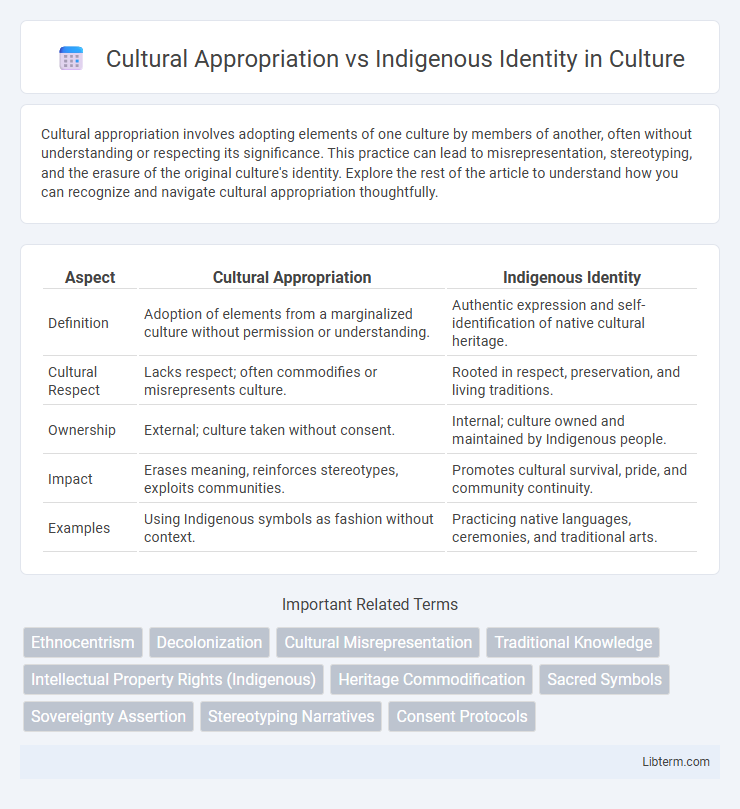Cultural appropriation involves adopting elements of one culture by members of another, often without understanding or respecting its significance. This practice can lead to misrepresentation, stereotyping, and the erasure of the original culture's identity. Explore the rest of the article to understand how you can recognize and navigate cultural appropriation thoughtfully.
Table of Comparison
| Aspect | Cultural Appropriation | Indigenous Identity |
|---|---|---|
| Definition | Adoption of elements from a marginalized culture without permission or understanding. | Authentic expression and self-identification of native cultural heritage. |
| Cultural Respect | Lacks respect; often commodifies or misrepresents culture. | Rooted in respect, preservation, and living traditions. |
| Ownership | External; culture taken without consent. | Internal; culture owned and maintained by Indigenous people. |
| Impact | Erases meaning, reinforces stereotypes, exploits communities. | Promotes cultural survival, pride, and community continuity. |
| Examples | Using Indigenous symbols as fashion without context. | Practicing native languages, ceremonies, and traditional arts. |
Understanding Cultural Appropriation: Definition and Context
Cultural appropriation refers to the adoption or use of elements from one culture by members of another culture, often without permission or understanding, which can lead to misrepresentation or exploitation of the original culture. This concept is particularly significant in the context of Indigenous identity, where cultural symbols, attire, language, and traditions hold deep spiritual and communal significance that is often commodified or disrespectfully used by outsiders. Understanding the historical context of colonization, power imbalances, and ongoing marginalization is essential to grasp why cultural appropriation impacts Indigenous communities profoundly and why protecting Indigenous cultural heritage is crucial for their identity and sovereignty.
The Roots of Indigenous Identity
The roots of Indigenous identity are deeply embedded in ancestral traditions, languages, and spiritual practices that have been preserved through generations despite colonial disruption. Cultural appropriation undermines this identity by commodifying and misrepresenting sacred symbols and customs without consent, leading to the erosion of authentic Indigenous heritage. Protecting Indigenous identity requires recognizing and respecting the sovereignty of Indigenous peoples over their cultural expressions and knowledge.
Historical Background: Encounters and Exchanges
Historical encounters between colonizers and Indigenous peoples resulted in significant cultural exchanges, often marked by imbalance and exploitation. Indigenous identity has been deeply affected by these interactions, where cultural elements were frequently appropriated without acknowledgment, leading to misrepresentation and loss of traditional knowledge. Understanding this historical context is crucial for addressing the ongoing impacts of cultural appropriation on Indigenous communities' rights and self-determination.
Power Dynamics and Cultural Ownership
Cultural appropriation occurs when dominant groups exploit Indigenous identities without permission, undermining the sovereignty and integrity of Indigenous cultures. Power dynamics reinforce unequal control over cultural narratives, often silencing Indigenous voices and perpetuating stereotypes. Respecting cultural ownership requires acknowledging Indigenous peoples' rights to self-representation and safeguarding their intangible heritage from commodification.
Impact of Appropriation on Indigenous Communities
Cultural appropriation often distorts and commodifies Indigenous traditions, leading to loss of cultural significance and spiritual meaning within Indigenous communities. This exploitation contributes to harmful stereotypes, undermines Indigenous identity, and perpetuates historical injustices tied to colonialism. The continued misrepresentation through appropriation diminishes efforts toward cultural preservation and self-determination for Indigenous peoples.
Celebrating vs. Exploiting: Where’s the Line?
Cultural appropriation occurs when elements of Indigenous identity are taken out of context, stripped of meaning, and used for aesthetic or commercial gain, often perpetuating stereotypes. Celebrating Indigenous culture involves respect, acknowledgment, and collaboration that honors traditions and supports Indigenous communities' autonomy. The line is crossed when cultural symbols and practices are commodified without consent, erasing Indigenous voices and undermining their lived experiences.
The Role of Media and Popular Culture
Media and popular culture often blur the lines between cultural appreciation and appropriation, affecting Indigenous identity by shaping public perceptions and reinforcing stereotypes. The portrayal of Indigenous symbols, attire, and traditions without proper context or respect can lead to misrepresentation and cultural erasure. Amplifying authentic Indigenous voices in media is essential to preserving cultural integrity and promoting accurate, respectful narratives.
Legal and Ethical Perspectives
Legal frameworks addressing cultural appropriation often emphasize the protection of Indigenous intellectual property rights, including trademarks and copyrights related to traditional knowledge and cultural expressions. Ethical perspectives highlight the importance of respecting Indigenous identity by ensuring community consent and preventing exploitation or misrepresentation of cultural symbols. International instruments like the United Nations Declaration on the Rights of Indigenous Peoples (UNDRIP) reinforce these principles by affirming Indigenous peoples' rights to maintain and control their cultural heritage.
Pathways to Respectful Cultural Engagement
Respectful cultural engagement involves recognizing and honoring Indigenous identity by seeking permission, understanding cultural significance, and supporting Indigenous-led initiatives. Emphasizing education about Indigenous histories and customs helps prevent cultural appropriation and fosters authentic connections. Collaborative partnerships that prioritize Indigenous voices ensure cultural exchange is conducted with dignity and respect, promoting mutual benefit.
Amplifying Indigenous Voices and Representation
Amplifying Indigenous voices and representation strengthens cultural preservation and counters cultural appropriation by ensuring authentic narratives are prioritized. Indigenous-led media, art, and educational platforms elevate diverse experiences, fostering respect and accurate understanding of Indigenous identities. Increasing Indigenous participation in decision-making processes promotes cultural sovereignty and challenges misrepresentations perpetuated by mainstream society.
Cultural Appropriation Infographic

 libterm.com
libterm.com